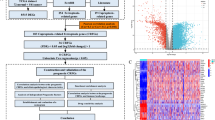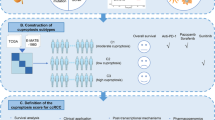Abstract
Cuproptosis is a newly discovered cell death induced by excessive copper in mitochondria distinct from any known forms of apoptosis. Role of cuproptosis has not been well-reported in cancer, especially in clear-cell renal cell carcinoma (ccRCC). We comprehensively interrogated cuproptotic gene signature in ccRCC by reproducing multi-omics datasets and found cuproptosis was decreased in ccRCC compared with normal kidney. Cuproptosis identified a subgroup with significantly better prognosis. Functional annotation supported increased tricarboxylic acid cycle activity and decreased hypoxia signaling corroborated by metabolomics. Cuproptotic tumors showed decreased angiogenesis but were sensitive to Sunitinib and Sorafenib. Cuproptotic level in ccRCC cell lines showed robust negative correlation with copper ionophore Elesclomol. All findings support a respiratory subtype of ccRCC identified by cuproptosis.



Similar content being viewed by others
Data availability
All data from the current study was retrieved from public genomic datasets and no new dataset was generated.
Abbreviations
- ccRCC:
-
Clear cell renal cell carcinoma
- CDF:
-
The cumulative distribution function
- CNV:
-
Copy number variation
- CORE:
-
Consumption and release
- DepMap:
-
Dependency map portal
- GDSC:
-
Genomics of drug sensitivity in cancer database
- GISTIC:
-
The genomic identification of significant targets in cancer
- GSE:
-
Gene set enrichment
- GSEA:
-
Gene set enrichment analysis
- GSVA:
-
Gene set variation analysis
- ICIs:
-
Immune checkpoints inhibitors
- IC50:
-
The half maximal inhibitory concentration
- IHC:
-
Immunohistochemical
- NES:
-
Normalized enrichment score
- OS:
-
Overall survival
- ROC:
-
The receiver operating characteristic
- ssGSEA:
-
Single sample gene set enrichment analysis
- TCA cycle:
-
Tricarboxylic acid cycle
- TCGA-KIRC:
-
The cancer genome atlas of kidney renal clear cell carcinoma
- TILs:
-
Tumor infiltrating lymphocytes
- TKIs:
-
Tyrosine kinase inhibitors
- TPM:
-
Transcripts per kilobase million
References
Sung H et al (2021) Global cancer statistics 2020: GLOBOCAN estimates of incidence and mortality worldwide for 36 cancers in 185 countries. CA Cancer J Clin 71(3):209–249
Siegel RL, Miller KD, Jemal A (2020) Cancer statistics, 2020. CA Cancer J Clin 70(1):7–30
Gupta K et al (2008) Epidemiologic and socioeconomic burden of metastatic renal cell carcinoma (mRCC): a literature review. Cancer Treat Rev 34(3):193–205
Powles T, ESMO Guidelines Committee (2021) Recent eUpdate to the ESMO Clinical Practice Guidelines on renal cell carcinoma on cabozantinib and nivolumab for first-line clear cell renal cancer: Renal cell carcinoma: ESMO Clinical Practice Guidelines for diagnosis, treatment and follow-up. Ann Oncol 32(3):422–423
Braun DA et al (2021) Beyond conventional immune-checkpoint inhibition - novel immunotherapies for renal cell carcinoma. Nat Rev Clin Oncol 18(4):199–214
Labbé S, Thiele DJ (1999) Pipes and wiring: the regulation of copper uptake and distribution in yeast. Trends Microbiol 7(12):500–505
Aggett PJ, Fairweather-Tait S (1998) Adaptation to high and low copper intakes: its relevance to estimated safe and adequate daily dietary intakes. Am J Clin Nutr 67(5 Suppl):1061S-1063S
Tsvetkov P et al (2022) Copper induces cell death by targeting lipoylated TCA cycle proteins. Science 375(6586):1254–1261
Tang D, Chen X, Kroemer G (2022) Cuproptosis: a copper-triggered modality of mitochondrial cell death. Cell Res 32(5):417–418
Gatto F, Nookaew I, Nielsen J (2014) Chromosome 3p loss of heterozygosity is associated with a unique metabolic network in clear cell renal carcinoma. Proc Natl Acad Sci USA 111(9):E866–E875
Razafinjatovo C et al (2016) Characterization of VHL missense mutations in sporadic clear cell renal cell carcinoma: hotspots, affected binding domains, functional impact on pVHL and therapeutic relevance. BMC Cancer 16:638
Kaelin WG Jr (2008) The von Hippel-Lindau tumour suppressor protein: O2 sensing and cancer. Nat Rev Cancer 8(11):865–873
Semenza GL (2013) HIF-1 mediates metabolic responses to intratumoral hypoxia and oncogenic mutations. J Clin Invest 123(9):3664–3671
Hakimi AA et al (2016) An integrated metabolic atlas of clear cell renal cell carcinoma. Cancer Cell 29(1):104–116
Liberti MV, Locasale JW (2016) The warburg effect: how does it benefit cancer cells? Trends Biochem Sci 41(3):211–218
Hatakeyama H et al (2018) Investigation of metabolomic changes in sunitinib-resistant human renal carcinoma 786-O cells by capillary electrophoresis-time of flight mass spectrometry. Biol Pharm Bull 41(4):619–627
Sato T et al (2019) Value of global metabolomics in association with diagnosis and clinicopathological factors of renal cell carcinoma. Int J Cancer 145(2):484–493
Nam H et al (2021) The TGF-beta/HDAC7 axis suppresses TCA cycle metabolism in renal cancer. JCI Insight. https://doi.org/10.1172/jci.insight.148438
Qu Y et al (2022) A proteogenomic analysis of clear cell renal cell carcinoma in a Chinese population. Nat Commun 13(1):2052
Hanzelmann S, Castelo R, Guinney J (2013) GSVA: gene set variation analysis for microarray and RNA-seq data. BMC Bioinformatics 14:7
Subramanian A et al (2005) Gene set enrichment analysis: a knowledge-based approach for interpreting genome-wide expression profiles. Proc Natl Acad Sci U S A 102(43):15545–15550
Jain M et al (2012) Metabolite profiling identifies a key role for glycine in rapid cancer cell proliferation. Science 336(6084):1040–1044
Geeleher P, Cox N, Huang RS (2014) pRRophetic: an R package for prediction of clinical chemotherapeutic response from tumor gene expression levels. PLoS ONE 9(9):e107468
Uhlén M et al (2015) Tissue-based map of the human proteome. Science. https://doi.org/10.1126/science.1260419
Liu J et al (2018) Loss of SETD2 induces a metabolic switch in renal cell carcinoma cell lines toward enhanced oxidative phosphorylation. J Proteome Res. https://doi.org/10.1021/acs.jproteome.8b00628
Li L et al (2019) Integrated genomic and proteomic analyses reveal novel mechanisms of the methyltransferase SETD2 in renal cell carcinoma development. Mol Cell Proteomics 18(3):437–447
Ljungberg B et al (2022) European Association of Urology Guidelines on Renal Cell Carcinoma: the 2022 update. Eur Urol. https://doi.org/10.1016/j.eururo.2022.03.006
Jones AT et al (2019) Efficacy of Dual inhibition of glycolysis and glutaminolysis for therapy of renal lesions in Tsc2+/− mice. Neoplasia 21(2):230–238
Wang S et al (2021) Comprehensive analysis of ferroptosis regulators with regard to PD-L1 and immune infiltration in clear cell renal cell carcinoma. Front Cell Dev Biol 9:676142
Dixon SJ et al (2012) Ferroptosis: an iron-dependent form of nonapoptotic cell death. Cell 149(5):1060–1072
Bacigalupa ZA, Rathmell WK (2020) Beyond glycolysis: hypoxia signaling as a master regulator of alternative metabolic pathways and the implications in clear cell renal cell carcinoma. Cancer Lett 489:19–28
Xu Y et al (2022) Genomic profiling and response to immune checkpoint inhibition plus tyrosine kinase inhibition in FH-deficient renal cell carcinoma. Eur Urol. https://doi.org/10.1016/j.eururo.2022.05.029
Brewer GJ (2016) Copper control as an antiangiogenic anticancer therapy: lessons from treating Wilson’s disease. Exp Biol Med 226(7):665–673
Redman BG et al (2003) Phase II trial of tetrathiomolybdate in patients with advanced kidney cancer. Clin Cancer Res 9(5):1666–1672
Acknowledgements
None.
Funding
This study was sponsored in part by National Natural Science Foundation of China (Grant Nos. 81874123 and 81772709) and by Beijing Advanced Innovation Center for Food Nutrition and Human Health, Beijing Technology and Business University (BTBU).
Author information
Authors and Affiliations
Contributions
CF, YL, XZ and YL: carried out in silico analysis. KL, LT and CF: participated in the study design. CF, HJ and HW: retrieved data. CF and KL: drafted the manuscript. LT: undertook revision. All authors read and approved the final manuscript.
Corresponding authors
Ethics declarations
Conflict of interest
The authors declare that they have no conflict of interest to disclose.
Ethical approval
Not available.
Consent to participate
Not available.
Consent for publication
All authors read and approved the final manuscript.
Additional information
Publisher's Note
Springer Nature remains neutral with regard to jurisdictional claims in published maps and institutional affiliations.
Rights and permissions
Springer Nature or its licensor holds exclusive rights to this article under a publishing agreement with the author(s) or other rightsholder(s); author self-archiving of the accepted manuscript version of this article is solely governed by the terms of such publishing agreement and applicable law.
About this article
Cite this article
Li, K., Tan, L., Li, Y. et al. Cuproptosis identifies respiratory subtype of renal cancer that confers favorable prognosis. Apoptosis 27, 1004–1014 (2022). https://doi.org/10.1007/s10495-022-01769-2
Accepted:
Published:
Issue Date:
DOI: https://doi.org/10.1007/s10495-022-01769-2




